#henry ii of castile
Explore tagged Tumblr posts
Text
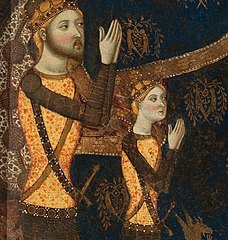

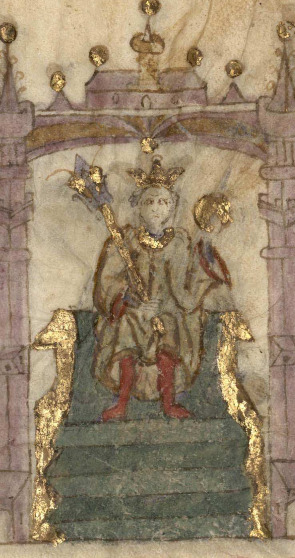
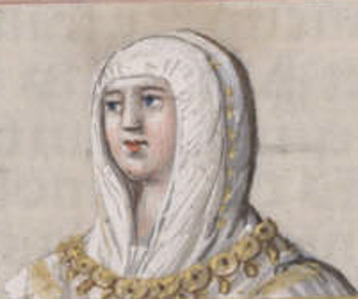
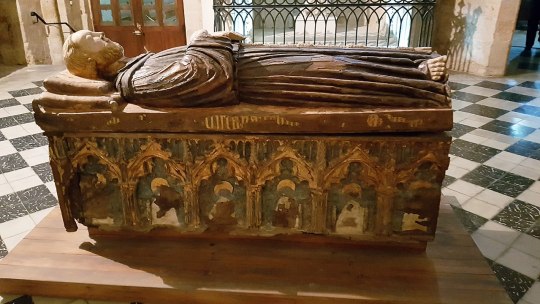
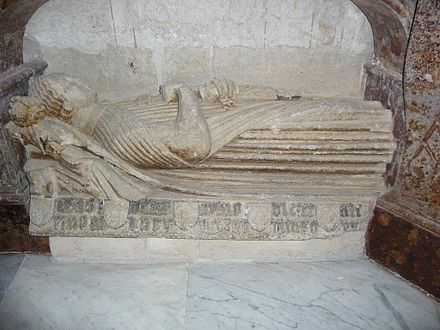

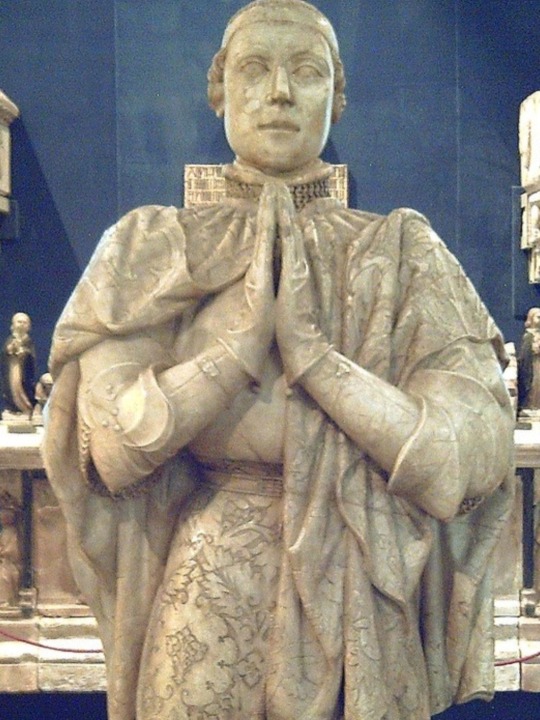
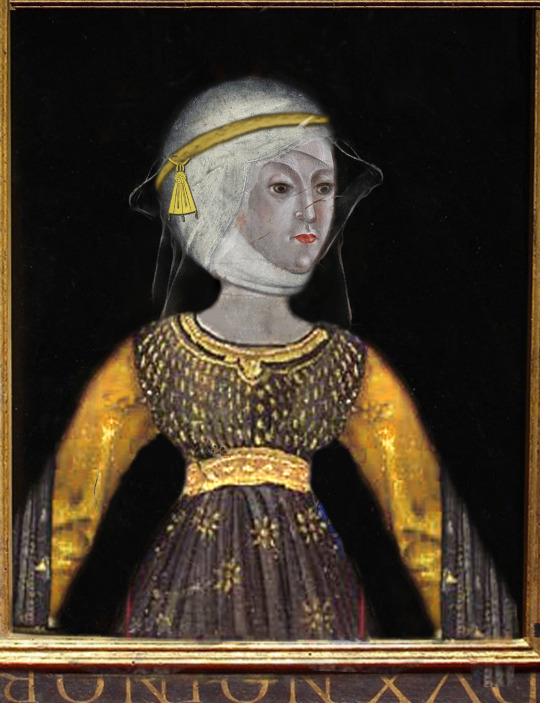
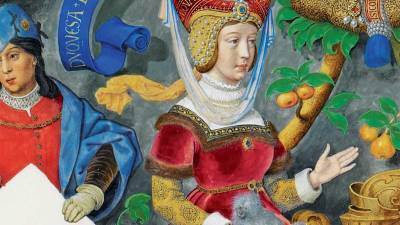
The Bastard Kings and their families
This is series of posts are complementary to this historical parallels post from the JON SNOW FORTNIGHT EVENT, and it's purpouse to discover the lives of medieval bastard kings, and the following posts are meant to collect portraits of those kings and their close relatives.
In many cases it's difficult to find contemporary art of their period, so some of the portrayals are subsequent.
1) Henry II of Castile ( 1334 – 1379), son of Alfonso XI of Castile and Leonor de Guzmán; and his son with Juana Manuel de Villena, John I of Castile (1358 – 1390)
2) His wife, Juana Manuel de Villena (1339 – 1381), daughter of Juan Manuel de Villena and his wife Blanca de la Cerda y Lara; with their daughter, Eleanor of Castile (1363 – 1415/1416)
3) His father, Alfonso XI of Castile (1311 – 1350), son of Ferdinand IV of Castile and his wife Constance of Portugal
4) His mother, Leonor de Guzmán y Ponce de León (1310–1351), daughter of Pedro Núñez de Guzmán and his wife Beatriz Ponce de León
5) His brother, Tello Alfonso of Castile (1337–1370), son of Alfonso XI of Castile and Leonor de Guzmán
6) His brother, Sancho Alfonso of Castile (1343–1375), son of Alfonso XI of Castile and Leonor de Guzmán
7) Daughters in law:
I. Eleonor of Aragon (20 February 1358 – 13 August 1382), daughter of Peter IV of Aragon and his wife Eleanor of Sicily; John I of Castile's first wife
II. Beatrice of Portugal (1373 – c. 1420) daughter of Ferdinand I of Portugal and his wife Leonor Teles de Meneses; John I of Castile's second wife
Son in law:
III. Charles III of Navarre (1361 –1425), son of Charles II of Navarre and Joan of Valois; Eleanor of Castile's huband
8) His brother, Peter I of Castile (1334 – 1369), son of Alfonso XI of Castile and Mary of Portugal
9) His niece, Isabella of Castile (1355 – 1392), daughter of Peter I of Castile and María de Padilla
10) His niece, Constance of Castile (1354 – 1394), daughter of Peter I of Castile and María de Padilla
#jonsnowfortnightevent2023#henry ii of castile#john i of castile#juana manuel de villena#eleanor of castile#alfonso xi of castile#leonor de guzmán#tello alfonso of castile#sancho alfonso of castile#peter i of castile#constance of castile#isabella of castile#asoiaf#a song of ice and fire#day 10#echoes of the past#historical parallels#medieval bastard kings#bastard kings and their families#eleanor of aragon#beatrice of portugal#charles iii of navarre#canonjonsnow
18 notes
·
View notes
Text

All the blossoms in my garden 🪴
An Angevin-Plantagenets family tree I made for my medieval art collection zine, “If All The World Were Mine!” The physical edition is now available, so check it out if you can :D
#the plantagenets#plantagenets#medieval#12th century#geoffrey of anjou#geoffrey plantagenet#Matilda of england#matilda lady of the english#henry ii of england#eleanor of aquitaine#henry the young king#matilda duchess of saxony#richard the lionheart#geoffrey duke of brittany#eleanor of castile#joanna of sicily#john lackland#john i of england#richard i of england#louis vii of france#philip ii of france#philip augustus#whew thats a lotta names#melusine#my art#family tree
75 notes
·
View notes
Note
Did henry vii had a tensed relationship with the trastamara couple from the very beginning ?
No, I don’t think so. Well, he wanted a really big dowry, but they were willing to pay at first.
2 notes
·
View notes
Text
A VISIT TO KING'S LANGLEY
King’s Langley was once home to a massive Plantagenet palace, built out of the remnants of a hunting lodge of Henry III for Edward I’s Queen, Eleanor of Castile. She furnished it lavishly, with carpets and baths. There were shields decorating the hall and a painted picture of four knights going to a tournament, while the expansive gardens were planted with vines. After her death, the palace was…
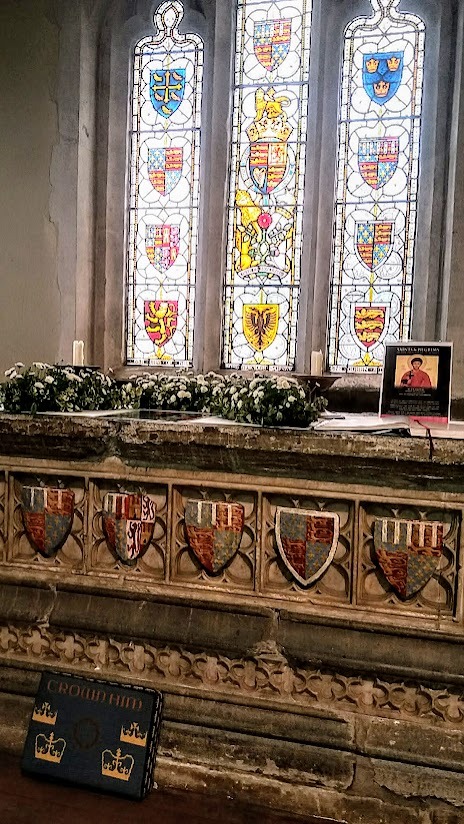
View On WordPress
#Anne Mortimer#camels#Cecily Neville#Christmas#Clarendon Palace#clocks#Dominican friaries#Edmund of Langley#Edward II#Edward III#Eleanor of Castile#fire#Henry III#Henry IV#Isabel of Castile#Joan of Navarre#John of Wheathampstead#King&039;s Langley#palaces#Piers Gaveston#Reformation#Richard Earl of Cambridge#Richard II#royal tombs
12 notes
·
View notes
Text
Blanche, Marguerite, and Queenship
Blanche's actions as queen dowager amount to no more than those of her grandmother and great-grandmother. A wise and experienced mother of a king was expected to advise him. She would intercede with him, and would thus be a natural focus of diplomatic activity. Popes, great Churchmen and great laymen would expect to influence the king or gain favour with him through her; thus popes like Gregory IX and Innocent IV, and great princes like Raymond VII of Toulouse, addressed themselves to Blanche. She would be expected to mediate at court. She had the royal authority to intervene in crises to maintain the governance of the realm, as Blanche did during Louis's near-fatal illness in 1244-5, and as Eleanor did in England in 1192.
In short, Blanche's activities after Louis's minority were no more and no less "co-rule" than those of other queen dowagers. No king could rule on his own. All kings- even Philip Augustus- relied heavily on those they trusted for advice, and often for executive action. William the Breton described Brother Guérin as "quasi secundus a rege"- "as if second to the king": indeed, Jacques Krynen characterised Philip and his administrators as almost co-governors. The vastness of their realms forced the Angevin kings to rely even more on the governance of others, including their mothers and their wives. Blanche's prominent role depended on the consent of her son. Louis trusted her judgement. He may also have found many of the demands of ruling uncongenial. Blanche certainly had her detractors at court, but she was probably criticsed, not for playing a role in the execution of government, but for influencing her son in one direction by those who hoped to influence him in another.
The death of a king meant that there was often more than one queen. Blanche herself did not have to deal with an active dowager queen: Ingeborg lived on the edges of court and political life; besides, she was not Louis VIII's mother. Eleanor of Aquitaine did not have to deal with a forceful young queen: Berengaria of Navarre, like Ingeborg, was retiring; Isabella of Angoulême was still a child. But the potential problem of two crowned, anointed and politically engaged queens is made manifest in the relationship between Blanche and St Louis's queen, Margaret of Provence.
At her marriage in 1234 Margaret of Provence was too young to play an active role as queen. The household accounts of 1239 still distinguish between the queen, by which they mean Blanche, and the young queen — Margaret. By 1241 Margaret had decided that she should play the role expected of a reigning queen. She was almost certainly engaging in diplomacy over the continental Angevin territories with her sister, Queen Eleanor of England. Churchmen loyal to Blanche, presumably at the older queen’s behest, put a stop to that. It was Blanche rather than Margaret who took the initiative in the crisis of 1245. Although Margaret accompanied the court on the great expedition to Saumur for the knighting of Alphonse in 1241, it was Blanche who headed the queen’s table, as if she, not Margaret, were queen consort. In the Sainte-Chapelle, Blanche of Castile’s queenship is signified by a blatant scattering of the castles of Castile: the pales of Provence are absent.
Margaret was courageous and spirited. When Louis was captured on Crusade, she kept her nerve and steadied that of the demoralised Crusaders, organised the payment of his ransom and the defence of Damietta, in spite of the fact that she had given birth to a son a few days previously. She reacted with quick-witted bravery when fire engulfed her cabin, and she accepted the dangers and discomforts of the Crusade with grace and good humour. But her attempt to work towards peace between her husband and her brother-in-law, Henry III, in 1241 lost her the trust of Louis and his close advisers — Blanche, of course, was the closest of them all - and that trust was never regained. That distrust was apparent in 1261, when Louis reorganised the household. There were draconian checks on Margaret's expenditure and almsgiving. She was not to receive gifts, nor to give orders to royal baillis or prévôts, or to undertake building works without the permission of the king. Her choice of members of her household was also subject to his agreement.
Margaret survived her husband by some thirty years, so that she herself was queen mother, to Philip III, and was still a presence ar court during the reign of her grandson Philip IV. But Louis did not make her regent on his second, and fatal, Crusade in 1270. In the early 12605 Margarer tried to persuade her young son, the future Philip III, to agree to obey her until he was thirty. When Philip told his father, Louis was horrified. In a strange echo of the events of 1241, he forced Philip to resile from his oath to his mother, and forced Margaret to agree never again to attempt such a move. Margaret had overplayed her hand. It meant that she was specifically prevented from acting with those full and legitimate powers of a crowned queen after the death of her husband that Blanche, like Eleanor of Aquitaine, had been able to deploy for the good of the realm.
Why was Margaret treated so differently from Blanche? Were attitudes to the power of women changing? Not yet. In 1294 Philip IV was prepared to name his queen, Joanna of Champagne-Navarre, as sole regent with full regal powers in the event of his son's succession as a minor. She conducted diplomatic negotiations for him. He often associated her with his kingship in his acts. And Philip IV wanted Joanna buried among the kings of France at Saint-Denis - though she herself chose burial with the Paris Franciscans. The effectiveness and evident importance to their husbands of Eleanor of Provence and Eleanor of Castile in England led David Carpenter to characterise late thirteenth-century England as a period of ‘resurgence in queenship’.
The problem for Margaret was personal, rather than institutional. Blanche had had her detractors at court. It is not clear who they were. There were always factions at courts, not least one that centred around Margaret, and anyone who had influence over a king would have detractors. They might have been clerks with misgivings about women in general, and powerful women in particular, and there may have been others who believed that the power of a queen should be curtailed, No one did curtail Blanche's — far from it. By the late chirteenth century the Capetian family were commissioning and promoting accounts of Louis IX that praise not just her firm and just rule as regent, but also her role as adviser and counsellor — her continuing influence — during his personal rule. As William of Saint-Pathus put it, because she was such a ‘sage et preude femme’, Louis always wanted ‘sa presence et son conseil’. But where Blanche was seen as the wisest and best provider of good advice that a king could have, a queen whose advice would always be for the good of the king and his realm, Margaret was seen by Louis as a queen at the centre of intrigue, whose advice would not be disinterested. Surprisingly, such formidable policical players at the English court as Simon de Montfort and her nephew, the future Edward I, felt that it was worthwhile to do diplomatic business through Margaret. Initially, Henry III and Simon de Montfort chose Margaret, not Louis, to arbitrate between them. She was a more active diplomat than Joinville and the Lives of Louis suggest, and probably, where her aims coincided with her husband’s, quite effective.
To an extent the difference between Blanche’s and Margaret’s position and influence simply reflected political reality. Blanche was accused of sending rich gifts to her family in Spain, and advancing them within the court. But there was no danger that her cultivation of Castilian family connections could damage the interests of the Capetian realm. Margaret’s Provençal connections could. Her sister Eleanor was married to Henry III of England. Margaret and Eleanor undoubtedly attempted to bring about a rapprochement between the two kings. This was helpful once Louis himself had decided to come to an agreement with Henry in the late 1250s, but was perceived as meddlesome plotting in the 1240s. Moreover, Margaret’s sister Sanchia was married to Henry's younger brother, Richard of Cornwall, who claimed the county of Poitou, and her youngest sister, Beatrice, countess of Provence, was married to Charles of Anjou. Sanchia’s interests were in direct conflict with those of Alphonse of Poitiers; and Margaret herself felt that she had dowry claims in Provence, and alienated Charles by attempting to pursue them. Indeed, her ill-fated attempt to tie her son Philip to her included clauses that he would not ally himself with Charles of Anjou against her.
Lindy Grant- Blanche of Castile, Queen of France
#xiii#lindy grant#blanche of castile queen of france#blanche de castille#grégoire ix#innocent iv#raymond vii de toulouse#aliénor d'aquitaine#louis ix#philippe ii#guérin#louis viii#marguerite de provence#aliénor de provence#alphonse de poitiers#henry iii of england#philippe iii#jeanne i de navarre#philippe iv#simon de montfort#edward i of england#jean de joinville#sancia de provence#béatrice de provence#charles i d'anjou
16 notes
·
View notes
Text
Below the cut I have made a list of each English and British monarch, the age of their mothers at their births, and which number pregnancy they were the result of. Particularly before the early modern era, the perception of Queens and childbearing is quite skewed, which prompted me to make this list. I started with William I as the Anglo-Saxon kings didn’t have enough information for this list.
House of Normandy
William I (b. c.1028)
Son of Herleva (b. c.1003)
First pregnancy.
Approx age 25 at birth.
William II (b. c.1057/60)
Son of Matilda of Flanders (b. c.1031)
Third pregnancy at minimum, although exact birth order is unclear.
Approx age 26/29 at birth.
Henry I (b. c.1068)
Son of Matilda of Flanders (b. c.1031)
Fourth pregnancy at minimum, more likely eighth or ninth, although exact birth order is unclear.
Approx age 37 at birth.
Matilda (b. 7 Feb 1102)
Daughter of Matilda of Scotland (b. c.1080)
First pregnancy, possibly second.
Approx age 22 at birth.
Stephen (b. c.1092/6)
Son of Adela of Normandy (b. c.1067)
Fifth pregnancy, although exact birth order is uncertain.
Approx age 25/29 at birth.
Henry II (b. 5 Mar 1133)
Son of Empress Matilda (b. 7 Feb 1102)
First pregnancy.
Age 31 at birth.
Richard I (b. 8 Sep 1157)
Son of Eleanor of Aquitaine (b. c.1122)
Sixth pregnancy.
Approx age 35 at birth.
John (b. 24 Dec 1166)
Son of Eleanor of Aquitaine (b. c.1122)
Tenth pregnancy.
Approx age 44 at birth.
House of Plantagenet
Henry III (b. 1 Oct 1207)
Son of Isabella of Angoulême (b. c.1186/88)
First pregnancy.
Approx age 19/21 at birth.
Edward I (b. 17 Jun 1239)
Son of Eleanor of Provence (b. c.1223)
First pregnancy.
Age approx 16 at birth.
Edward II (b. 25 Apr 1284)
Son of Eleanor of Castile (b. c.1241)
Sixteenth pregnancy.
Approx age 43 at birth.
Edward III (b. 13 Nov 1312)
Son of Isabella of France (b. c.1295)
First pregnancy.
Approx age 17 at birth.
Richard II (b. 6 Jan 1367)
Son of Joan of Kent (b. 29 Sep 1326/7)
Seventh pregnancy.
Approx age 39/40 at birth.
House of Lancaster
Henry IV (b. c.Apr 1367)
Son of Blanche of Lancaster (b. 25 Mar 1342)
Sixth pregnancy.
Approx age 25 at birth.
Henry V (b. 16 Sep 1386)
Son of Mary de Bohun (b. c.1369/70)
First pregnancy.
Approx age 16/17 at birth.
Henry VI (b. 6 Dec 1421)
Son of Catherine of Valois (b. 27 Oct 1401)
First pregnancy.
Age 20 at birth.
House of York
Edward IV (b. 28 Apr 1442)
Son of Cecily Neville (b. 3 May 1415)
Third pregnancy.
Age 26 at birth.
Edward V (b. 2 Nov 1470)
Son of Elizabeth Woodville (b. c.1437)
Sixth pregnancy.
Approx age 33 at birth.
Richard III (b. 2 Oct 1452)
Son of Cecily Neville (b. 3 May 1415)
Eleventh pregnancy.
Age 37 at birth.
House of Tudor
Henry VII (b. 28 Jan 1457)
Son of Margaret Beaufort (b. 31 May 1443)
First pregnancy.
Age 13 at birth.
Henry VIII (b. 28 Jun 1491)
Son of Elizabeth of York (b. 11 Feb 1466)
Third pregnancy.
Age 25 at birth.
Edward VI (b. 12 Oct 1537)
Son of Jane Seymour (b. c.1509)
First pregnancy.
Approx age 28 at birth.
Jane (b. c.1537)
Daughter of Frances Brandon (b. 16 Jul 1517)
Third pregnancy.
Approx age 20 at birth.
Mary I (b. 18 Feb 1516)
Daughter of Catherine of Aragon (b. 16 Dec 1485)
Fifth pregnancy.
Age 30 at birth.
Elizabeth I (b. 7 Sep 1533)
Daughter of Anne Boleyn (b. c.1501/7)
First pregnancy.
Approx age 26/32 at birth.
House of Stuart
James I (b. 19 Jun 1566)
Son of Mary I of Scotland (b. 8 Dec 1542)
First pregnancy.
Age 23 at birth.
Charles I (b. 19 Nov 1600)
Son of Anne of Denmark (b. 12 Dec 1574)
Fifth pregnancy.
Age 25 at birth.
Charles II (b. 29 May 1630)
Son of Henrietta Maria of France (b. 25 Nov 1609)
Second pregnancy.
Age 20 at birth.
James II (14 Oct 1633)
Son of Henrietta Maria of France (b. 25 Nov 1609)
Fourth pregnancy.
Age 23 at birth.
William III (b. 4 Nov 1650)
Son of Mary, Princess Royal (b. 4 Nov 1631)
Second pregnancy.
Age 19 at birth.
Mary II (b. 30 Apr 1662)
Daughter of Anne Hyde (b. 12 Mar 1637)
Second pregnancy.
Age 25 at birth.
Anne (b. 6 Feb 1665)
Daughter of Anne Hyde (b. 12 Mar 1637)
Fourth pregnancy.
Age 27 at birth.
House of Hanover
George I (b. 28 May 1660)
Son of Sophia of the Palatinate (b. 14 Oct 1630)
First pregnancy.
Age 30 at birth.
George II (b. 9 Nov 1683)
Son of Sophia Dorothea of Celle (b. 15 Sep 1666)
First pregnancy.
Age 17 at birth.
George III (b. 4 Jun 1738)
Son of Augusta of Saxe-Gotha (b. 30 Nov 1719)
Second pregnancy.
Age 18 at birth.
George IV (b. 12 Aug 1762)
Son of Charlotte of Mecklenburg-Strelitz (b. 19 May 1744)
First pregnancy.
Age 18 at birth.
William IV (b. 21 Aug 1765)
Son of Charlotte of Mecklenburg-Strelitz (b. 19 May 1744)
Third pregnancy.
Age 21 at birth.
Victoria (b. 24 May 1819)
Daughter of Victoria of Saxe-Coburg-Saafield (b. 17 Aug 1786)
Third pregnancy.
Age 32 at birth.
Edward VII (b. 9 Nov 1841)
Daughter of Victoria of the United Kingdom (b. 24 May 1819)
Second pregnancy.
Age 22 at birth.
House of Windsor
George V (b. 3 Jun 1865)
Son of Alexandra of Denmark (b. 1 Dec 1844)
Second pregnancy.
Age 20 at birth.
Edward VIII (b. 23 Jun 1894)
Son of Mary of Teck (b. 26 May 1867)
First pregnancy.
Age 27 at birth.
George VI (b. 14 Dec 1895)
Son of Mary of Teck (b. 26 May 1867)
Second pregnancy.
Age 28 at birth.
Elizabeth II (b. 21 Apr 1926)
Daughter of Elizabeth Bowes-Lyon (b. 4 Aug 1900)
First pregnancy.
Age 25 at birth.
Charles III (b. 14 Nov 1948)
Son of Elizabeth II of the United Kingdom (b. 21 Apr 1926)
First pregnancy.
Age 22 at birth.
381 notes
·
View notes
Text
The relationship between infanta Catalina ‘Katherine’ of Aragon and her father, Fernando ‘Ferdinand’ II of Aragon
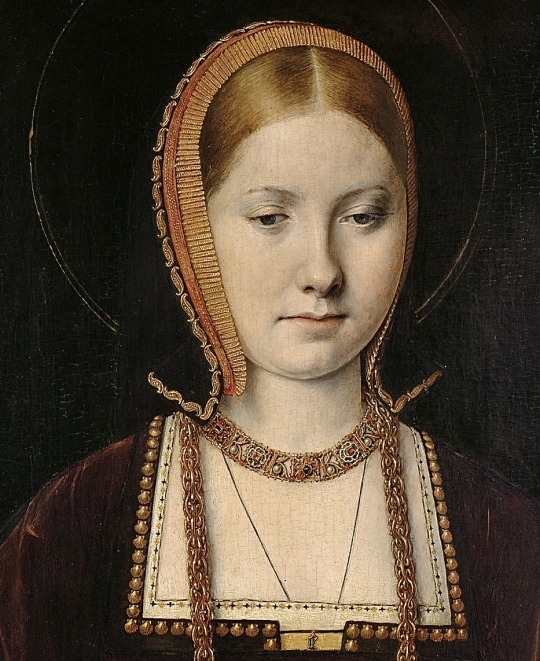
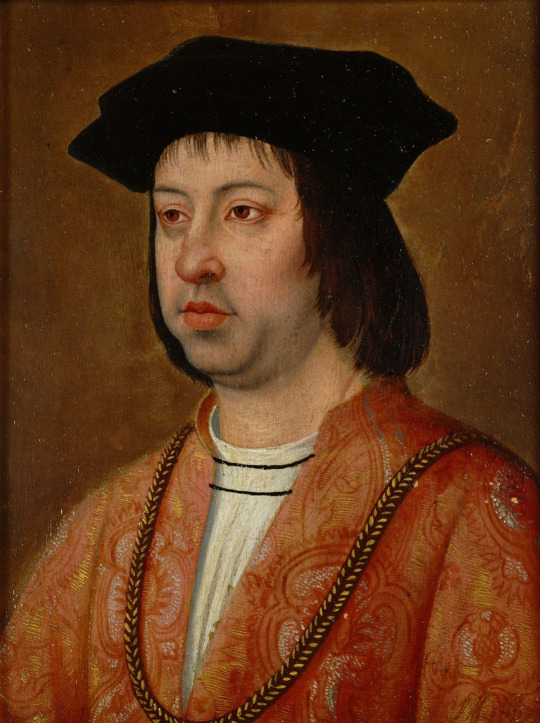
Fernando II of Aragon is known to have been a cheating husband (which, the queen, Isabel of Castile, his wife, was very aware of) and a not-so-great of a father; at least to his daughters, whom he did not care much about, seeing them as potential pawns and bargaining chips to make powerful alliances. He was, above all, an astute and cold-blooded politician and, as such, this Aragonese king was not the sentimental type of man.
It was no secret that he and the queen of Castile favoured their son and heir, Juan, prince of Asturias and Girona, over anyone else. (The queen herself would lovingly refer to him as ‘my angel’).
However, if anything has become clear to me after doing my research, is that both, the Iberian Queen and King had a soft spot for their little one, Catalina.
Queen Isabel would coddle and protect the infanta in a way she had not done with the rest of her daughters, partly due to the fact she had lost Juan and her eldest daughter, Isabel of Aragon consecutively (1497 and 1498, respectively) and partly because Catalina was her ‘baby’.
She purposely delayed Catalina’s parting to England until the very last minute, (which Fernando didn’t object to, either) and even then, she did so rather reluctantly. What is more, the queen had had the habit to accompany the infantas in their journey away from home for a little while and wave them goodbye. However, when Catalina headed for A Coruña in 1501, Isabel, either because she was feeling physically unwell or was not emotionally strong enough to do so, abstained from travelling alongside her.
Now, going back to the king.
We know the young princess would write to her father a handful of missives throughout the years, which were essentially a plea for help due to the awful state of misery she and her tiny household were in after Arthur’s premature demise in 1502.
King Henry VII was distraught by the death of his eldest son and his wife, Elizabeth of York, (the latter had passed away in 1503 after giving birth to a daughter who also died, a couple days later) and little did he care about the well-being of a foreign princess.
Not only did he fail to provide for her (the infanta had to resort to selling some of the stuff she had brought from Spain, and even then, this was not enough to sustain herself and her ladies) but also refused to return half of the dowry he had got from the Spanish monarchs, while keeping Catalina a hostage within his realm and refusing to let her return to her home country.
The situation worsened when the Castilian queen died in 1504 (aged 53) and the infanta was no longer as a desirable match as she had been when her mother was still alive.
King Fernando left many of Catalina’s letters unanswered. He did not listen to Henry VII’s demands that he paid for the rest of the princess’ dowry, either (be it because he refused to, or because he had no power to do so: his daughter, Juana, had inherited Castile, and that was where the remaining money from Catalina’s dowry allegedly was being kept. Furthermore, Fernando was not well-liked among Castilians, and his daughter, now queen, would probably not take heed of any of Fernando’s petitions for help due to the power and influence her husband, Philip of Hasburg had over her).
What Fernando did, instead, in order to improve Catalina’s welfare, was to strip de la Puebla from his title of ambassador for the Crown of Aragon in England in 1507, and grant it to his daughter, making her the first European woman ambassador in history. He would also teach the princess how to encode her letters, while instructing her thoroughly on politics, so that she could navigate the Tudor court unscathed and perform her duties as ambassador flawlessly (which we know she did).
When Henry VII died in 1509, his son Henry succeeded him to the throne as Henry VIII at 18 years old. The new young king had had the choice to marry whomever he wanted, and so, he married Catalina.
After spending seven years as a virtual captive at Durnham House in London, the whole ordeal was finally over. An extract from a letter Fernando sent his daughter after he was informed his Catalina would, in fact, become Queen of England reads: ‘(...) Porque de todas mis fijas soys vos la que mas entrañablemente amo, por vuestra virtud y merecimiento, y por el mucho amor y obediencia que conozco que como buena hija me teneys’. // ‘(…) Because, of all my daughters, you are the one I love the most, for your virtue and your merit, and for the great love and obedience that I know that, you as my daughter profess me’.
TL;DR: Despite Ferdinand II’s many faults as a husband and a father, it is safe to believe he liked and favoured his youngest child (in his own way) over the rest of his daughters.
Bibliography:
— Liss, Peggy K. Isabel the Queen: Life and Times. Second edition (Revised)., University of Pennsylvania Press, 2004.
— Pérez Martín, María Jesús. María Tudor. La Gran Reina Desconocida. Fourth ed., Rialp S.A, 2020.
— Tremlett, Giles. Catherine of Aragon: Henry’s Spanish Queen. Faber, 2011.
— Everett Green, Mary Anne. Letters of Royal and Illustrious Ladies of Great Britain, from the Commencement of the Twelfth Century to the Close of the Reign of Queen Mary I. Internet Archive. London, H. Colburn, 1970.
#katherine of aragon#catherine of aragon#usersansa#history#Tudor#disclaimer: I dislike Ferdinand as much as the next person I just wanted to give my two cents…
23 notes
·
View notes
Text
Daena should have been the mother of Daeron II the Good Targaryen

Crédits to @wweskywalker
Daena was the true embodiment of a Targaryen.
I think if Viserys had married Daena before Baelor had the chance to lock her away, Daena could have had the chance to see the bigger picture of how to govern, and while trying to get justice for Daeron I Targaryen, like asking for the heads of the people who killed him and retribution from every Dornish House as the weight of every hostage on gold, and then Daena could have made the very same deal of betrothing Daeron II and Myriah Martell and later that of Daenerys and Maron, while betrothing Rhaena to a Marcher Lord, like a Lord of House Oakheart, to balance the alliances with Dorne and the Marches. The Oakhearts were a family that respected peace and liked the Faith and they would have treated Rhaena well.
They could have sent Baelor to a Sept where he could not bother anyone and therefore everyone would be happier.
Daena could have kept using the crown of her mother and thus it would've stayed within House Targaryen, and there would not have been Blackfyre Rebellions.
...
I imagine Daena convincing Daeron to let her marry Viserys and wanting to court and be courted by Viserys before marrying him, and then in the second year of their marriage they can have Daeron (in honor of her beloved brother/his eldest nephew), followed by Aegon (a more respectful and actual smart Aegon; and to honor Daena's father/Viserys' brother), Aemon the Dragon Knight, and Daenerys.
Rhaena could have had two daughters: Naerys and Visaella (we can be safe the name Naerys was used before the Conquest as it was considered a significant Targaryen name for Naerys to compensate for the Rogare blood in her in ASOIAF; and the name Visaella is possible as a variant of the name Visenya/Viserra).
Daeron would still marry Myriah Martell, and Daenerys to Maron.
Naerys and Aemon would marry and have a daughter Aerea Targaryen who would marry into House Dondarrion and become the mother of Kiera Dondarrion, the wife of Valarr Targaryen, and later Daeron The Drunken Targaryen.
Whereas Visaella could marry into House Dayne and be the mother of Dyanna Dayne.
(Rhaena was a scholar, but it's probable she developed agoraphobia after being stuck in the Maidenvault for so long; and she deserves to be part of the line of Azor Ashai.)
Aegon could have married Melissa Blackwood and have had Mya, Gwenys and Brynden, and through a relationship with Serenei have Shiera, who would be legitimized out of love and not to spite anyone; he could work as a Hand for his brother, and be a good person, and given his hard and long time working as a Hand for his brother and later his nephew Aerys, Aegon was legitimately known and recognized as Aegon IV "The Helpful".
Peace with Dorne would be done and steadfast.
Daena by Viserys' side would take wise decisions and consider the option to avenge Daeron but still work to have peace.
And it would be interesting because if they rule together it's completely different to how it was with her grandparents/his parents but still important; because with Rhaenyra and Daemon it was Rhaenyra the one taking decisions while Daemon enacted them, now it is shared by Daena and Viserys through a double claim. You can see the parallels to Henry VII and Elizabeth of York or Ferdinand II and Isabella of Castile.
And also, because Aegon III and Daenaera, and Daena above everything deserved to be in the main line of Azor Ashai, and because Viserys really deserved someone better than the abusive daughter of his kidnapper as a wife who left him in a very vulnerable position. Larra left when Viserys was becoming an adult who was wiser now and more mature as well, and when also her family had regained some of their riches, how convenient.
In this scenario Daenerys would look like her greatx4grandmothers Daena and Rhaena - it's nothing against Naerys, but we have to erase her since Larra would never have married Viserys, because it's possible part of the reason why Viserys didn't spend so much time with Aegon IV, Aemon and Naerys was because they looked like Larra; Aegon like Larra and Lysandro, - Viserys' biggest abusers - Aemon like Larra in a softer way, and Naerys like Larra and Viserys himself, an eternal reminder of what he went through with Larra.
Larra Rogare and her family only brought grief to Viserys' life, and while she may not have had another choice but leave her children behind, it is interesting to see Larra only returned to Lys once her older brother Moredo was able to get some of their old possessions back.
Maybe in other circumstances the relationship of Viserys and Larra could have been different but it was not, and Daena would have been perfect together, a reminder of Rhaenyra and Daemon.
#daeron the young dragon#daena targaryen#daena the defiant#viserys ii targaryen#daena x viserys ii#viserys ii x daena#daena & viserys ii targaryen#viserys ii & daena targaryen#daena should have been the first queen of her name#queen daena i targaryen#rhaena targaryen (daughter of aegon iii and daenaera)#rhaena targaryen (daughter of daenaera and aegon iii)#rhaena targaryen (daughter of aegon iii)#daeron i targaryen#daeron ii targaryen#daeron the good#daena x viserys#viserys x daena#aegon iv targaryen#larra rogare#targaryen oc#targaryen ocs
21 notes
·
View notes
Text
The attraction of Eleanor of Aquitaine to post-medieval historians, novelists and artists is obvious. Heiress in her own right to Aquitaine, one of the wealthiest fiefs in Europe, she became in turn queen of France by marriage to Louis VII (1137–52) and of England by marriage to Henry II (1154–89). She was the mother of two of England’s most celebrated (or notorious) kings, Richard I and John, and played an important role in the politics of both their reigns. She was a powerful woman in an age assumed (not entirely correctly) to be dominated by men. She was associated with some of the great events and movements of her age: the crusades (she participated in the Second Crusade, and organized the ransom payments to free Richard I from the imprisonment that he suffered returning from the Third); the development of vernacular literature and the idea of courtly love (as granddaughter of the ‘first troubadour’ William IX of Aquitaine, she was also a patron of some of the earliest Arthurian literature in French, and featured in one of the foundational works on courtly love); and the Plantagenet–Capetian conflict that foreshadowed centuries of struggle between England and France (her divorce from Louis VII and marriage to Henry II took Aquitaine out of the Capetian orbit, and created the ‘Angevin Empire’). She enjoyed a long life (she was about eighty years old at the time of her death in 1204) and produced nine children who lived to adulthood. The marriages of her off spring linked her (and the Plantagenet and Capetian dynasties) to the royal houses of Castile, Sicily and Navarre, and to the great noble lines of Brittany and Blois-Champagne in France and the Welfs in Germany. A sense of both the geographical and temporal extent of Eleanor’s world can be appreciated when we consider an example from the crusades. Eleanor accompanied her husband Louis VII on the Second Crusade in 1147–9; when Louis IX went on crusade over a hundred years later, he left France in the care of Blanche of Castile, a Spanish princess and Eleanor’s granddaughter, whose marriage to Louis’s father had been arranged by Eleanor. Just this single example shows her direct influence spanning a century, two crusades and three kingdoms.
— Michael R. Evans, Inventing Eleanor: The Medieval and Post-Medieval Image of Eleanor of Aquitaine
#slay#eleanor of aquitaine#historicwomendaily#english history#french history#12th century#women in history#richard I#king John#Henry II#angevins
17 notes
·
View notes
Text
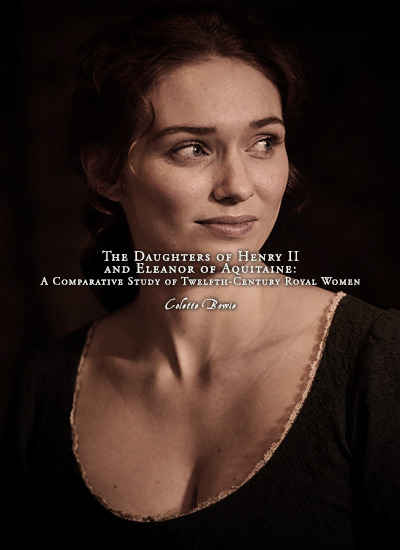

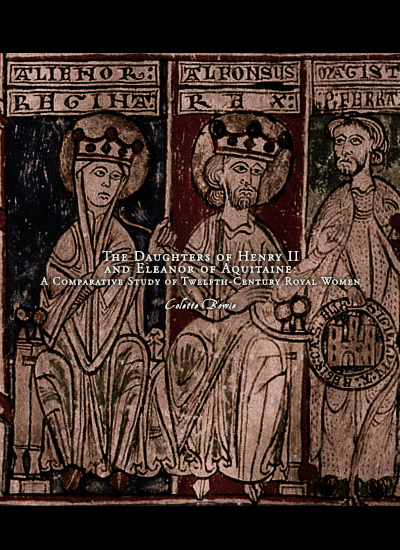
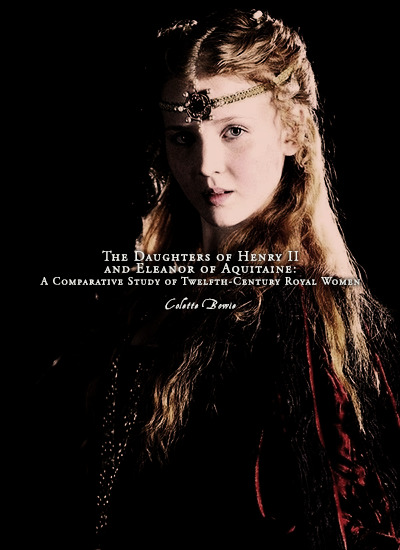


Favorite History Books || The Daughters of Henry II and Eleanor of Aquitaine: A Comparative Study of Twelfth-Century Royal Women by Colette Bowie ★★★★☆
This study compares and contrasts the experiences of the three daughters of Henry II and Eleanor of Aquitaine. The exogamous marriages of Matilda, Leonor, and Joanna, which created dynastic links between the Angevin realm and Saxony, Castile, Sicily and Toulouse, served to further the political and diplomatic ambitions of their parents and spouses. It might be expected that their choices in religious patronage and dynastic commemoration would follow the customs and patterns of their marital families, yet the patronage and commemorative programmes of Matilda, Leonor, and Joanna provide evidence of possible influence from their natal family which suggests a coherent sense of family consciousness. To discern why this might be the case, an examination of the childhoods of these women has been undertaken (Part I), to establish what emotional ties to their natal family may have been formed at this impressionable time. In Part II, the political motivations for their marriages are analysed, demonstrating the importance of these dynastic alliances, as well as highlighting cultural differences and similarities between the courts of Saxony, Castile, Sicily, and the Angevin realm. Dowry and dower portions (Part III) are important indicators of the power and strength of both their natal and marital families, and give an idea of the access to economic resources which could provide financial means for patronage. Having established possible emotional ties to their natal family, and the actual material resources at their disposal, the book moves on to an examination of the patronage and dynastic commemorations of Matilda, Leonor and Joanna (Parts IV-V), in order to discern patterns or parallels. Their possible involvement in the burgeoning cult of Thomas Becket, their patronage of Fontevrault Abbey, the names they gave to their children, and finally the ways in which they and their immediate families were buried, suggest that all three women were, to varying degrees, able to transplant Angevin family customs to their marital lands. The resulting study, the first of its kind to consider these women in an intergenerational dynastic context, advances the hypothesis that there may have been stronger emotional ties within the Angevin family than has previously been allowed for.
#historyedit#history books#litedit#house of plantagenet#english history#medieval#french history#european history#women's history#history#nanshe's graphics
73 notes
·
View notes
Text
Ages of English Queens at First Marriage
I have only included women whose birth dates and dates of marriage are known within at least 1-2 years, therefore, this is not a comprehensive list. For this reason, women such as Philippa of Hainault and Anne Boleyn have been omitted.
This list is composed of Queens of England when it was a sovereign state, prior to the Acts of Union in 1707. Using the youngest possible age for each woman, the average age at first marriage was 17.
Eadgifu (Edgiva/Ediva) of Kent, third and final wife of Edward the Elder: age 17 when she married in 919 CE
Ælfthryth (Alfrida/Elfrida), second wife of Edgar the Peaceful: age 19/20 when she married in 964/965 CE
Emma of Normandy, second wife of Æthelred the Unready: age 18 when she married in 1002 CE
Ælfgifu of Northampton, first wife of Cnut the Great: age 23/24 when she married in 1013/1014 CE
Edith of Wessex, wife of Edward the Confessor: age 20 when she married in 1045 CE
Matilda of Flanders, wife of William the Conqueror: age 20/21 when she married in 1031/1032 CE
Matilda of Scotland, first wife of Henry I: age 20 when she married in 1100 CE
Adeliza of Louvain, second wife of Henry I: age 18 when she married in 1121 CE
Matilda of Boulogne, wife of Stephen: age 20 when she married in 1125 CE
Empress Matilda, wife of Henry V, HRE, and later Geoffrey V of Anjou: age 12 when she married Henry in 1114 CE
Eleanor of Aquitaine, first wife of Louis VII of France and later Henry II of England: age 15 when she married Louis in 1137 CE
Isabella of Gloucester, first wife of John Lackland: age 15/16 when she married John in 1189 CE
Isabella of Angoulême, second wife of John Lackland: between the ages of 12-14 when she married John in 1200 CE
Eleanor of Provence, wife of Henry III: age 13 when she married Henry in 1236 CE
Eleanor of Castile, first wife of Edward I: age 13 when she married Edward in 1254 CE
Margaret of France, second wife of Edward I: age 20 when she married Edward in 1299 CE
Isabella of France, wife of Edward II: age 13 when she married Edward in 1308 CE
Anne of Bohemia, first wife of Richard II: age 16 when she married Richard in 1382 CE
Isabella of Valois, second wife of Richard II: age 6 when she married Richard in 1396 CE
Joanna of Navarre, wife of John IV of Brittany, second wife of Henry IV: age 18 when she married John in 1386 CE
Catherine of Valois, wife of Henry V: age 19 when she married Henry in 1420 CE
Margaret of Anjou, wife of Henry VI: age 15 when she married Henry in 1445 CE
Elizabeth Woodville, wife of Sir John Grey and later Edward IV: age 15 when she married John in 1452 CE
Anne Neville, wife of Edward of Lancaster and later Richard III: age 14 when she married Edward in 1470 CE
Elizabeth of York, wife of Henry VII: age 20 when she married Henry in 1486 CE
Catherine of Aragon, wife of Arthur Tudor and later Henry VIII: age 15 when she married Arthur in 1501 CE
Jane Seymour, third wife of Henry VIII: age 24 when she married Henry in 1536 CE
Anne of Cleves, fourth wife of Henry VIII: age 25 when she married Henry in 1540 CE
Catherine Howard, fifth wife of Henry VIII: age 17 when she married Henry in 1540 CE
Jane Grey, wife of Guildford Dudley: age 16/17 when she married Guildford in 1553 CE
Mary I, wife of Philip II of Spain: age 38 when she married Philip in 1554 CE
Anne of Denmark, wife of James VI & I: age 15 when she married James in 1589 CE
Henrietta Maria of France, wife of Charles I: age 16 when she married Charles in 1625 CE
Catherine of Braganza, wife of Charles II: age 24 when she married Charles in 1662 CE
Anne Hyde, first wife of James II & VII: age 23 when she married James in 1660 CE
Mary of Modena, second wife of James II & VII: age 15 when she married James in 1673 CE
Mary II of England, wife of William III: age 15 when she married William in 1677 CE
112 notes
·
View notes
Text
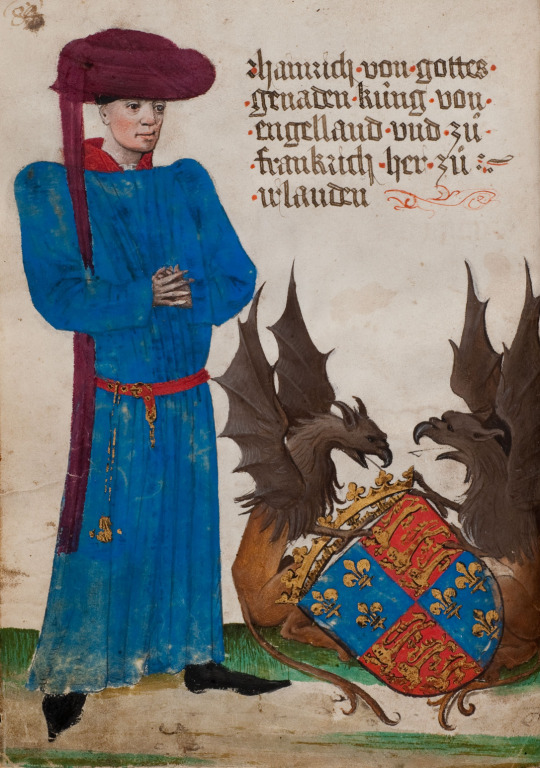
Drawing of Henry VI of England by Jörg von Ehingen.
From 1457-1459, Swabian knight Jörg von Ehingen traveled Europe participating in various campaigns; throughout, he kept a journal and sketchbook of his impressions of the many royal courts he passed through. His compilation includes portraits, in the order of his visits, of Duke Ladislaus V of Austria, Charles VII of France, Henry IV of Castile, Henry VI of England, Alfonso V of Portugal, Janus III of Cyprus, Duke René of Anjou, John II of Aragon, and James II of Scotland.
#we love a contemporaneous portrait from an eyewitness#absolutely dapper hat#you may be familiar with Alfonso V's incredible poulaine shoes and/or his terrible heraldic lion#Henry's got pretty swell poulaines himself#altho I have just noticed his lil skelly hands#plantagenets#manuscript
64 notes
·
View notes
Note
Do you know that Edmund of Langley, 1st Duke of York's wife Isabella is likely to have an affair with a man from the Howard family and gave birth to the Earl of Cambridge, Richard? Isabella's will was made with Edmund's consent, which may indicate that although Edmund did not want his property to go to Richard, he did not hate their mother and son. Perhaps they were just colleagues who had to have children together
I'm not quite sure I'm following your ask. I think you're asking about Isabel (or Isabella) of Castile, Duchess of York and the assertion that Richard, Earl of Cambridge was a son born from her adulterous liaison? However, the man she was accused of having an affair with was not a member of the Howard family but John Holland (or Holand), Earl of Huntington. Huntington was the son of Joan of Kent and Thomas Holland and thus half-brother to Richard II. Huntington was married to Elizabeth of Lancaster who was the sister of Henry IV, which would have been made things awkward (to say the least) when Richard II was deposed. Huntington was killed during the Epiphany Rising which aimed to restore Richard to the throne. .
Jenny Stratford recently published work arguing that the affair did not take place and that Cambridge was legitimate, as far as we can tell. I'll talk you through the evidence and her arguments against it below the cut.
Thomas Walsingham's commentary on Isabel
Thomas Walsingham wrote that Isabel was:
A lady of sensual and self-indulgent disposition, she had been worldly and lustful; yet in the end by the grace of Christ, she repented and was converted. By the command of the king she was buried at his manor of Langley with the friars, where, so it is said, the bodies of many traitors had been placed together.
Stratford points out that Walsingham got the date of her death wrong, placing it two years after her death occurred, which suggests he was probably not well-informed about his life. She suggests that the image of emerges from Isabel's will contrasts sharply against the image Walsingham provides:
The duchess herself emerges in a favourable light. In face of her husband’s debts, the arrangement to provide an income for the seven-year-old Richard by transferring to Richard II most of her jewels and plate, her personal chattels, was eminently practical. It limited the possibility of claims by the duke’s creditors, while grants previously made to Isabel were subsequently reassigned to fund the annuity. These provisions seem very unlikely to indicate that young Richard was illegitimate, any more than a gap of twelve years between the age of the oldest and youngest of the duchess’s three living children was necessarily significant. The duke’s will drawn up a decade after Isabel’s death speaks of his devotion to her.
It's also worth noting that Walsingham has something of a reputation for misogyny and for being unreliable - we now know that some of his assertions about Alice Perrers's background are groundless and serve to make her appear worse than she was, while Anna Duch argued that he effectively erased Anne of Bohemia from his account of Richard II's reign. He is also full of vitriol for Agnes Launcekrona and Katherine Swynford so it seems to me that we should treat his claims on women with great scepticism.
John Shirley's comments on Chaucer's Complaint of Mars
Forty years after Isabel's death, a scribe named John Shirley wrote an afterword on Geoffrey Chaucer's Complaint of Mars that linked it to a scandal involving "the lady of York" and John Holland. Connected with Walsingham's commentary, it's generally been taken as evidence that they had an affair.
Stratford argues that the Shirley's commentary is likely a garbled reference to the affair between Constance of York (Isabel's daughter) and Edmund Holland, Earl of Kent (John Holland's nephew) which the resulted in the birth of an illegitimate daughter, Eleanor. Following Kent's death, Eleanor claimed claimed her parents had married clandestinely before Kent married Lucia Visconti and that she was his rightful heir but her claims were rejected. Historians have suggested that Kent might have considering marrying Constance before the revelation that she had been involved in a plot against Henry IV meant he distanced himself from her.
Additionally, J. D. North argued that the astronomical framework contained within Complaint of Mars could have only applied to the year 1385 and aligns it with the beginning of the affair between Elizabeth of Lancaster and Huntington. Elizabeth had been married to John Hastings, heir to the earldom of Pembroke, in 1380 when she was 16 and Hastings was 8. However, the marriage was annulled in 1386 and Elizabeth soon after married Huntington on 24 June 1386. It is frequently asserted that Huntington and Elizabeth had embarked on an affair that resulted in a pregnancy, leading to the hasty annulment of Elizabeth's first marriage and her second marriage to Huntington though it isn't clear when their first child was born, though it was in 1386 or 1387. It may be that John Shirley's reference to the affair between "the lady of York" and Huntington may actually be referring to Huntington's affair with Elizabeth of Lancaster.
It may even be that the reference represents a garbled combination of the two affairs - Constance of York and Edmund Holland, Elizabeth of Lancaster and John Holland - recorded decades later. It might be noteworthy in this regard that Elizabeth and Huntington's first child was also named Constance (both Constances were named after Isabel's sister, Constanza or Constance of Castile), which would add to the confusion).
The wills of Cambridge's father and older brother.
The argument that Richard, Earl of Cambridge was illegitimate is based around the lack of reference to Cambridge in the wills of his father and older brother, where it is assumed that this represents that Cambridge was effectively, though not legally, disowned.
His brother, Edward 2nd Duke of York's will was written after Cambridge had been executed as a traitor for his role in the Southampton Plot. His lack of reference to Cambridge may simply be because Cambridge was dead and could not be a beneficiary. There may have also been concern that any reference to Cambridge, such a request for prayers for his brother's soul, could result in suspicion of Edward's own loyalties. From the surviving evidence, Edward also seems to have had a close relationship with Henry V so Cambridge's treason may well have driven a wedge between the brothers. In short: there are a lot of reasons why Edward might have avoided referencing Cambridge explicitly that were far more relevant to the circumstances his will was written in.
Stratford notes that "a testator may not include all his bequests in his will", which would apply to both Dukes of York. Edmund of Langley, 1st Duke of York left "nothing in the will to any of his three children" (my emphasis). He did, however, ask to be buried "near his beloved Isabel, formerly his companion". In short, there is no reason to presume Cambridge's exclusion was due to his being informally disowned by his father due to the adultery of his mother. York's will provides no support to the idea that he had a fraught relationship with Isabel, either.
Isabel's will makes special provision for Richard, Earl of Cambridge.
Isabel's will asked Richard II for provide an annuity of 500 marks for Cambridge against the surrender of her jewels and plate until appropriate lands could be found to furnish him with an income. This has led to the belief that Cambridge would not be supported by his father and brother and, in combination with the above, that this was because he was illegitimate.
Most of this is based on the transcript of her will published in Testamenta vetusta, which is a shortened extract of the full document which didn't include Isabel's many bequests to her husband (if you read something that claims Isabel left York nothing, the author is working from the abridged will, not the full text). Stratford's study is on the original will in its full form. As noted in your ask, Isabel required and received the permission of her husband to make this will. Stratford also notes that some of those mentioned in the will are Edmund, Duke of York's officers who also appear in his will, "strongly suggesting that the duke and the leading members of his familia were in full agreement with its provisions". In short, the idea that York was refusing to acknowledge or provide for Cambridge seems somewhat illogical given his involvement and the involvement of his officers in Isabel's will which was primarily concerned with providing for Cambridge.
Stratford argues that what the will represents is an effort by Isabel and York to provide for Cambridge "while protecting as far as possible the incomes of her husband and his heir."
The principal purpose of Isabel’s will was to provide for their youngest child, Richard, then aged seven. Edmund gave his wife full powers to dispose of her horses, jewels, robes, the furnishings of her chamber, and her other chattels. She made a number of bequests, notably including books, but offered the majority of her valuables to Richard II if he would agree to provide her younger son, his godson (filiol), with an income of 500 marks per year for life. If the king did not so wish, Isabel’s oldest son, then earl of Rutland, was invited to do so on the same terms.
At the time Isabel was drawing up her will, York was heavily in debt following his Portuguese expedition, had difficulty obtaining money due to him from the Crown, and didn't have lands commensurate with his status. York's executors were still struggling to pay his debts eight years after his death and when his eldest son died in 1415, the duchy of York remained bankrupt for twenty years. Stratford notes that the money raised by Isabel's jewels and plate would "circumvent claims on the duke by his creditors".
John Holland gave Isabel a gift.
Isabel's will mentions a "sapphire and diamond brooch" given to her by John Holland, Earl of Huntington which has been taken as evidence of their affair. Sometimes she is also said to have been given a gold cup and a chaplet of white flowers by Huntington, though Stratford points out the brooch is the only item actually said to have been given to her by Huntington and is one of three gifts from named donors (the others was a "little" gold tablet given to her by John of Gaunt and a gaming board of jasper from Leo of Armenia).
Firstly, while gifts of jewels to us seem to be strictly or largely romantic gestures, this very much wasn't the case within the Middle Ages, where the exchange of jewels was a normal part of aristocratic life, albeit serving an important function. We know that medieval nobles frequently exchanged gifts, including items they had been given by others, and it is a pure speculation to assume that Isabel "treasured" the brooch or even that she kept it because it was Huntington who had given to her. Furthermore, it is entirely possible that it was identified through the designation as a gift given to her by Huntington.
Secondly, if this is evidence of their affair which produced Cambridge, it's very odd that she didn't leave Huntington's gift to Cambridge but to her eldest son, Edward, who was York's acknowledged son and heir whose legitimacy has never been doubted.
Isabel left bequests to Holland.
Isabel left her Bibles and "the best fillet I have" to John Holland. Some have argued that this is unusual enough because Holland was the only person she gave gifts to who wasn't a "close member" of her family.
Outside of her husband and three children, Isabel also left bequests to Richard II, Anne of Bohemia, John of Gaunt and Eleanor de Bohun, Duchess of Gloucester, and Stratford groups with Eleanor as a member of Isabel's "wider family" and says it is credible they were friends, not lovers. The extent that Holland isn't a "close" member of her family can be debated: he was married to her niece (Elizabeth of Lancaster) and the half-brother of her nephew (Richard II).
Stratford says that Isabel may have made the bequest to Huntington in hope that that he would influence Richard II and John of Gaunt (who was Huntington's father-in-law and and close ally in the 1380s and named as an executor in Isabel's will) to ensure that the annuity she sought for Cambridge would become a reality.
Furthermore, Stratford suggests that the "best fillet" (which was probably a collar) may have been intended for Elizabeth of Lancaster, Huntington's wife. If so, this would rather point away from it being a memento from their affair.
There were a ten-year gap between Cambridge and his siblings.
The other main piece of evidence put forward is the large gap between Constance of York (b. c. 1375) and Cambridge (b. c. 1385). The supposition usually goes that having had two children (Edward, 2nd Duke of York was born c. 1373), Isabel and York had grown tired of each other's company and didn't have sex again, Isabel then embarked on an affair with Huntington that, some ten years after Constance's birth, left her pregnant and York allowed the child to be brought up as his son but refused to provide for him.
The problem with this scenario is that it is effectively a complete invention. The idea that York and Isabel were at odds is based around the idea of the affair and the speculation Cambridge was illegitimate. York never repudiated Isabel nor officially disowned Cambridge as a bastard. There are many possible reasons why there was such a large gap - fertility issues, miscarriages, bad luck, personal decisions, religious reasons (i.e. choosing to adopt a chaste marriage). Constance's birth may have been particularly difficult and York and Isabel decided not to chance sexual intercourse or to use the contraceptive methods available to them only to slip up. It's also possible that they may had other children who died too young to leave evidence behind and that the large gap between children wasn't that large in reality. After all, it seems we know very little about the births of their children, even the years are uncertain.
I know this is all speculative but so is the argument that they fell out. The point is that we don't have evidence to explain why beyond speculation.
Conclusion
A lot of the arguments for the affair based on tenuous links and are often based on the assumption that the affair was a historical fact and that Walsingham's comments on Isabel are an objective and reasonable account of her character. So the evidence that shows us a connection between Isabel and Huntington is often assumed to be evidence of a sexual relationship.
Take the brooch. It seems to be read as the equivalent of a man buying his lover an emerald necklace or diamond earrings. Except we know that the exchange of valuable jewels as gifts was a common aspect of medieval noble life that performed a vital function that very frequently had nothing to do with romantic or sexual feelings. We know, for example, that Henry VI gave Eleanor Cobham a brooch - it does not follow that they were therefore having an affair or that Henry harboured romantic feelings for his aunt.
That the brooch was mentioned in Isabel's will also tells us nothing. We don't know how she felt about it, only that she singled it out to be passed onto her eldest son (not Cambridge). It may be that she wanted him to have it because of he had admired it and, if it was a feminine piece, may have intended to give it onto his wife when he married. It's quite unremarkable that a medieval individual would identify a piece through noting who had given it to them and is not proof of romantic attachment. Isabel also mentioned gifts given to her by John of Gaunt and Leo of Armenia - should we assume she had affairs with them too?
On a similar note: that Isabel left items to Huntington is taken as proof of their romantic liaison. The bequest? Her best fillet (probably a collar, according to Stratford), which may well have been intended for Elizabeth of Lancaster, and her Bibles. They were likely valuable items but hardly proof of romantic involvement - such bequests were very common and would be utterly remarkable without the context of Shirley's commentary on their relationship.
It seems to me that there is good good reason to believe that John Shirley's commentary on Complaint of Mars, written decades after Isabel's death, may not have been about Isabel at all. She isn't named in the commentary and we have no clear, explicit evidence of this affair outside of the commentary itself. I think it was a garbled recollection of either Isabel's daughter, Constance of York's affair with Edmund Holland, Earl of Kent or of John Holland's affair with Elizabeth of Lancaster. We have clear, contemporary evidence of both these affairs - the existence of Constance's and Kent's daughter and this daughter's attempt to inherit Kent's estates, the annulment of Elizabeth's marriage to Hastings and her marriage to Huntington.
The evidence cited as "proof" of their affair is really nothing of the sort. Isabel's will attempted to provide for Cambridge in the face of York's (comparatively) small income and large debts. Huntington was a beneficiary but hardly the only one and not a particularly unusual choice. He gave Isabel a gift that was in keeping with the social custom of their class and time. York's will mentioned none of his children and he did not officially disown Cambridge. The lack of reference to Cambridge in his brother's will is easy to understand given it was written after Cambridge had been executed for treason. We have no real evidence of discontent between Isabel and York - he was obviously involved in the writing of her will and he requested burial with her in his own. Nor is there any account that records discord between them or separation, like we do for John of Gaunt and Constanza of Castile. York was buried with Isabel, as he had requested, and on their joint tomb-monument are Huntington's coat of arms (amongst many others). It seems very strange to me that York was so utterly furious about Isabel's adultery that he refused to provide for Cambridge, forcing Isabel to beg the king to provide for him, yet he chose to be buried with her, he chose as his second bride Huntington's niece, Joan Holland, and he chose to add the coat-of-arms with the man she had betrayed him with on their tomb monument (which was probably constructed sometime between 1393 and 1399). I don't think this picture holds up.
Walsingham did criticise Isabel for being "worldly and lustful" but Walsingham calling a woman a slut is pretty par for the course for him and he got facts of her life wrong. Nor does he report anything she actually did to deserve such a reputation. In others: scepticism is clearly needed. None of this adds up to very much. It isn't until Shirley wrote his commentary, decades later, that we find any reference to their affair. The rest are things that would be entirely unremarkable without Shirley's commentary directing us to see it as a romantic gesture.
Of course, the fact is that we can't prove she didn't have an affair and that Shirley was really referring to a more evidenced scandal. Proving a negative is hard. Even if we located, exhumed and DNA-tested the bodies of Cambridge, York and Huntington, we might confirm that Cambridge was really York's son (or Huntington's or the son of an unknown man) but we wouldn't be able to prove that Isabel didn't have sex with Huntington at some point in her life. We don't have evidence for every single time a medieval individual had sex and so we can't definitively rule out the possibility that an affair did occur. All we can say is the actual surviving evidence doesn't support the narrative that Isabel had an affair.
It's probably worth noting that Kathryn Warner also read Isabel's full will and still accepts the narrative of Isabel's infidelity, though she argues Cambridge should be given the benefit of the doubt where his illegitimacy is concerned. Personally, I find Stratford's reading of the will more credible than Warner's. I don't think the evidence cited as proof of Shirley's claim is actually evidence of an affair but the existence of a typical relationship between medieval nobles working as normal. Warner seems to contradict herself at times* and she doesn't seem to have been interested in questioning whether Isabel did or did not have an affair. I also think Stratford's extensive work on medieval manuscripts and the inventories of John, Duke of Bedford and Richard II lends credence to her claims.
Works Referenced
Jenny Stratford, "The Bequests of Isabel of Castile, 1st Duchess of York, and Chaucer’s ‘Complaint of Mars’", Creativity, Contradictions and Commemoration in the Reign of Richard II: Essays in Honour of Nigel Saul, eds. Jessica A. Lutkin and J. S. Hamilton (The Boydell Press 2022)
Jenny Stratford, "Isabel [Isabella] of Castile, duchess of Yorkunlocked (1355–1392)", Oxford Dictionary of National Biography (published 2022, updated 2023)
J. D. North, Chaucer's Universe (Oxford University Press 1988)
James P. Toomey (ed.), "A Household Account of Edward, Duke of York at Hanley Castle, 1409-10", Noble Household Management and Spiritual Discipline in Fifteenth-Century Worcestershire (Worcestershire Historical Society 2013).
John Evans, "XIV. Edmund of Langley and his Tomb", Archaeologia, vol. 46, no. 2, 1881
Kathryn Warner, John of Gaunt: Son of One King, Father of Another (Amberley 2022)
(also looked at the ODNB entries for York, Cambridge, Huntington and Elizabeth of Lancaster).
* After mentioning the brooch given to Isabel by Huntington, Warner states: "Isabel did not not mention other gifts she had received from anyone else". In an earlier chapter, Warner says "The 1392 will of Isabel of Castile, duchess of York and countess of Cambridge, reveals that Levon [Leo of Armenia] gave her a ‘tablet of jasper’ during this visit, which she bequeathed to John of Gaunt". Warner also repeats this within the chapter dealing with Isabel's will: "and ‘a tablet of jasper which the king of Armonie [King Levon of Armenia] gave me’ to John of Gaunt". How can Huntington's brooch be the only gift from anyone mentioned in her will when we've been told (twice) that Isabel's will includes a reference to a tablet of jasper gifted to her by Leo of Armenia? Additionally, Warner's arguments seems to be drawn from the preconceived notion that Isabel did have an affair so any evidence connecting her to Huntington must be evidence of the affair, regardless of how limited the evidence is - this is quite surprising, since it goes against one of her arguments against reading Isabella of France and Roger Mortimer's relationship as a love affair.
#ask#anon#isabel of castile duchess of york#john holland earl of huntington#edmund duke of york#richard earl of cambridge#i did just have the revelation cambridge was only a year and a bit older than henry v#god this is long
12 notes
·
View notes
Text
Jon was tired. I need sleep. He had been up half the night poring over maps, writing letters, and making plans with Maester Aemon. Even after stumbling into his narrow bed, rest had not come easily. He knew what he would face today, and found himself tossing restlessly as he brooded on Maester Aemon's final words.
"Allow me to give my lord one last piece of counsel", the old man had said, "the same counsel that I once gave my brother when we parted for the last time. He was three-and-thirty when the Great Council chose him to mount the Iron Throne. A man grown with sons of his own, yet in some ways still a boy. Egg had an innocence to him, a sweetness we all loved. Kill the boy within you, I told him the day I took ship for the Wall. It takes a man to rule. An Aegon, not an Egg. Kill the boy and let the man be born."
The old man felt Jon's face. "You are half the age that Egg was, and your own burden is a crueler one, I fear. You will have little joy of your command, but I think you have the strength in you to do the things that must be done. Kill the boy, Jon Snow. Winter is almost upon us. Kill the boy and let the man be born."
Jon II, A Dance with Dragons
It could be very interesting if a Great Northern Council is held at Winterfell for deciding who will be the next Lord of Winterfell/King in the North after the downfall of the Boltons.
Like, maybe this Northern Great Council parallels the Great Council for deciding the heir to the Iron Throne among Maekar I's children and/or their descendants, and in this case the Northern Great Council will choose the heir to the Noth among Ned's children.
We know that the Great Council offered the crown to Aemon and he rejected it and Egg was crowned instead. In my opinion, I think this Northern Great Council could offer the crown to Jon, since he is the eldest and most prepared sibling, and he will accept it because if duty.
I feel like there is a strong connection between Jon and Aemon & Aegon V, Jon accepting the crown due duty I feel like it reflects in some kind of sense the "Kill the boy and let the man be born" Aemon said to Egg and Jon, both the last time they were going to see Aemon and time before/when they became kings, Aemon went to the Wall to join the NW and Egg became Aegon the Unlikely, and Aemon left the Wall and died during the trip to Oldtown, and some time after that Jon could be crowned King in the North.
We could also take notes at Aegon V's nickname " the Unlikely", because he was the fourth son of a fourth son, and Jon becoming Lord of Winterfell/King in the North being a bastard isn't something expected for Westerosi society due to generally being classist and having prejudices towards bastards.
And I don't suscribe to what some people say about that Jon can't inherit and become king because he's a bastard, it's well-known that one of the main inspirations for Westeros is Medieval Europe, especially medieval English history, and there some other bastards that became kings, like William I the Conqueror (1028-1087), illegitimate son of Duke Robert I of Normandy and Herleva of Falaise, although I would say his Asoiaf equivalents are Aegon I the Conqueror and his bastard brother Orys Baratheon, plus there were others like Ramiro I of Aragon (1006-1063), Henry II of Castile (1334-1379), John I of Portugal (1357-1433) and Ferdinand I of Naples (1423-1494).
Plus if Robb's Will is brought to the discussion, Jon has been legitimised by Robb and could be another reason to be considered a good candidate by the Council.
#asoiaf#a song of ice and fire#jon snow#canonjonsnow#canonjon#adwd#maester aemon#aegon the unlikely#aemon targaryen#aegon v targaryen#egg#meta#valyrianscrolls
55 notes
·
View notes
Text
Petites Histoires du Monde
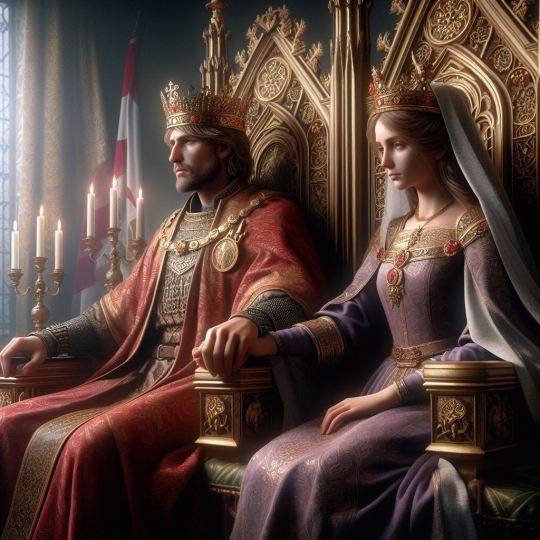
Listes des personnes et des OC pour l'instant :
- Baudouin IV de Jérusalem (5 histoires). (Plus à venir. )
Il est souvent associé à Alix de Tripoli, personnage fictif qui est la fille unique de Raymond III de Tripoli et qui a grandi à Jérusalem. Alix est douce, gentille, mais aussi intrépide et courageuse. Baudouin et Alix s'aiment infiniment, mais ils savent tous les deux que leur amour est impossible.
Mini-série : Guérison. Baudouin est guéri de la lèpre et décide quoi faire de sa vie. (À venir)
- Édouard Ier d'Angleterre (3 histoires) (Plus à venir. )
Il est souvent associé à sa femme Éléonore de Castille. Leur amour est inspirant et unique. Un OC peut apparaître également sous la forme d'Aliénor de Mercoeur, qui est la dame de compagnie et meilleure amie de la reine d'Angleterre.
Mini-série : Seconde Guerre des Barons avec le point de vue d'Henry III, Éléonore de Provence, Éléonore de Castille, Richard de Cornouailles et lord Édouard sur la bataille de Lewes de 1264. (Publié)
- Bohémond de Tarente (3 histoires) (Plus à venir. )
Bohémond est souvent associé à Alix de Sicile, une OC fictive qui est son épouse. Ils mettent du temps à se cerner l'un l'autre, mais après avoir découvert que sa femme n'est pas qu'une jolie chose à son bras, il est son plus fervent admirateur.
Mini-série : Chefs de la première croisade avec Godefroy de Bouillon, Baudouin de Boulogne, Hugues de Vermandois, Raymond de Saint-Gilles, Etienne de Blois, Robert de Flandres, Robert de Normandie, Adhémar de Monteil, Tancrède de Hauteville et bien sûr Bohémond. (En cours)
Personnages sans lien avec Bohémond de Tarente, Édouard Ier et Baudouin IV ou une mini-série.
- Louis IX de France, Saint-Louis (1 histoire)
- Édouard II d'Angleterre (À venir)
- Alphonse de Poitiers et sa femme Jeanne de Toulouse (À venir)
- Sybille de Jerusalem et Guy de Lusignan (À venir)
- Agnès de Courtenay (À venir)
- Amaury II de Jérusalem ( À venir)
- Aliénor d'Aquitaine ( À venir)
- Henry II d'Angleterre ( À venir)
- Richard cœur de Lion (À venir)
- Jean Sans Terre ( À venir)
Et bien d'autres....
Si vous voulez en voir plus n'hésitez pas à proposer des personnes ou des événements.
#fanfic#history medieval#medieval history#bohemond i of antioch#king baldwin#baldwin iv#edward ii#Edward I#booklr#france#england#eleonor of castile#eleanor of aquitaine#plantagenet#plantagenets
7 notes
·
View notes
Photo
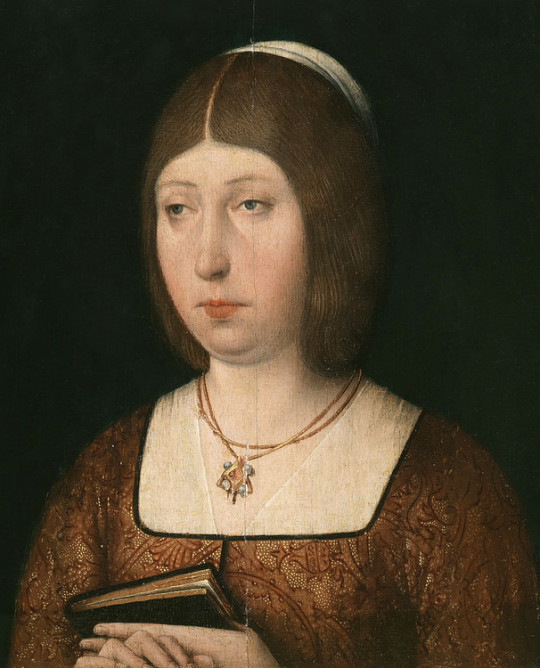
Isabella I of Castile
Isabella I of Castile (1451-1504), was Queen of Castile (r. 1474-1504) and of Aragon (r. 1479-1504) alongside her husband Ferdinand II of Aragon (1452-1516). Her reign included the unification of Spain, the reconquest of Granada, sponsoring Christopher Columbus in his voyage to explore the Caribbean, and the establishment of the Spanish Inquisition.
Early Life
Isabella was born 22 April 1451 in the town of Madrigal de las Altas Torres in Castile (which is now modern Spain) to John II of Castile (r. 1406-1454) and Isabella of Portugal (1447-1454). Despite having two brothers and spending much time with her mother in Arévalo where she participated in more ladylike activities, Isabella was soon drawn in and involved with the Castilian political world. While there were no laws against women being on the throne, Isabella was third in line because her brothers were higher up the succession line. The iron-willed and determined young woman was brought to the Court of Castile when she was in her early teenage years so that her father could keep an eye on her. Isabella was well-versed in Latin, and she studied history and theology, which furthered her religious convictions, which would be extremely influential in her actions as queen in the future.
Isabella's brother Enrique IV became king as Henry IV of Castile (r. 1454-1474), but discontent with his rule soon became vocalized as the kingdom was dissatisfied with his ineffective rule. Henry struggled with producing a legitimate heir, as his first marriage bore no children, and his only daughter, Juana (1462-1530), was believed to be an illegitimate child. He was unable to win back Granada, which had been under Muslim control since the mid-1200s, and had Jewish and Muslim advisors in place, damaging the image of Castile being a Christian kingdom.
To placate the nobles, Henry named his brother Alfonso (1453-1468) heir, but Alfonso had to marry his daughter so they could both rule. When Henry ultimately reneged on this deal and supported his daughter's claim, the nobles began their campaign to place Alfonso on the throne. When Alfonso died in 1468, of suspected poisoning, the nobles approached Isabella as she was also a legitimate candidate. She refused to take the crown and wished to wait for her brother to leave. Seeing this, Henry negotiated with the nobles and made Isabella his heir.
Continue reading...
19 notes
·
View notes